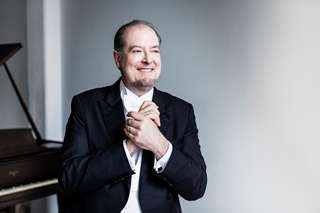|
Back
What’s in a Nickname? New York
Alice Tully Hall, Lincoln Center
02/27/2018 -
Ludwig van Beethoven: Piano Sonatas No. 8 in C minor (“Pathétique”), Op. 13, No. 23 in F minor (“Appassionata”), Op. 57, No. 21 in C major (“Waldstein”), Op. 53, & No. 14 in C-sharp minor (“Moonlight”), Op. 27, No. 2
Garrick Ohlsson (piano)

G. Ohlsson (© Dario Acosta)
“Weber says, As God pleases; Beethoven says, As Beethoven pleases!”
Ignaz Schuppanzigh, first violinist for the premieres of the late quartets
“When you’re out on a date and you turn on the Beethoven, the girls think that you’re an operator!”
Eddie Haskell
Some years ago Garrick Ohlsson was giving a late night Beethoven recital at Lincoln Center’s Kaplan Penthouse when he asked the rather intimate crowd if they would like to suggest an encore. Someone requested Mozart and Ohlsson responded that “Beethoven is in my head just now” and so stayed away from any other composer. He is apparently in this headspace once again and offered a quartet of spectacular and familiar pieces in a most unusual concert.
Mr. Ohlsson was a student of my own personal favorite Beethovenian scholar Claudio Arrau and learned from him the extremely valuable lesson that one need not overstretch the force of an attack but rather simply lean into it naturally. This particular student is a big man and thus no additional physical force is necessary to get one’s point across.
The four sonatas on the program are, of course, justly famous. I first learned the Pathétique as a pre-teen when it was the theme of the fine daily radio program of Karl Haas. I hadn’t heard Mr. Ohlsson for almost fifteen years and was pleased to note his more youthful, less corpulent image as he strode onto the Alice Tully stage. He seemed to be emphasizing the dynamic contrasts in the “Pathétique” and this was an interesting tack, but, a victim of his own success, this performance seemed to be about these voluminous discrepancies and not about the beauty of the melodic lines. It seemed from this tiny piece of evidence that Mr. Ohlsson had lost a half-step.
The extremely difficult “Appassionata” was almost Mr. Ohlsson’s undoing. There was an unacceptable amount of “fat fingering” spoiling the clean melodic lines and I began to feel like a creature from another time remembering the precision of this artist whilst listening to his struggles. It simply seemed that “this was not like the old days”.
But then: deus ex machina! After the intermission an apparently completely different pianist came out to entertain the sold-out crowd. Ohlsson dove into the “Waldstein” like an Olympian. Of the present quartet it can be argued that this is the most difficult to pull off and he did so brilliantly. Deliberately fast tempi in the Allegro con brio served to demonstrate that there was life in the old boy after all. There was even some stifled applause at the end of this first movement. Garrick Ohlsson had achieved what Nietzsche called “a nodding acquaintance with the music”. He was back!
Finally the “Moonlight”: that niggling sense of eminent doom with every approach was gone, replaced by that indescribable peace that one feels when listening to a master. Even the final romp through the Presto agitato was devoid of any serious mis-cues and was, oddly, made just a bit more exciting by the now perceived vulnerability of this artist. I decided to leave before the encores if any, as I simply did not want to alter my mood once again.
And why Beethoven? Because he fills the hall while Henze does not.
Fred Kirshnit
|